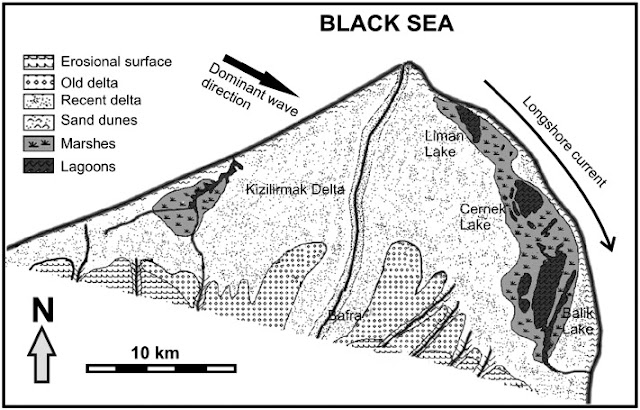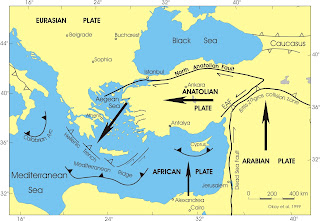Tsunamis affecting Turkey
According to Ready.gov,, tsunamis are caused by "seismic sea waves." These are not the same as "tidal waves." Tsunamis are created by underwater disturbances, such as earthquakes, landslides, volcanic eruption, or meteorites. Earthquakes, though, remain the predominant cause of tsunamis in this region.
About 10% of tsunamis worldwide occur in this Mediterranean region. Approximately one disastrous tsunami has taken place in this region each century.
In Turkey, tsunamis occur when earthquakes, primarily caused by the African Plate drifting north, are subducting underneath the Eurasian Plate, in the Mediterranean Sea, or in other waters surrounding Europe.
There have been three such occurrences which have been classified as tsunamis, since the year 365 A,D. (See dark blue "wave" symbols on map, above.) It is estimated that a total of 155 people have been killed in Turkey due to tsunamis. However, tsunamis are rare in this region..
To date, the strongest tsunami to impact Turkey, in terms of loss of life, injuries and property destruction, was a tsunami which occurred in the year 1344. According to historians, the wave itself registered a height of just two meters.
As a result of the devastating tsunami of December 26, 2004, which struck the Indian Ocean area and killed more than a quarter of a million people, countries in the North Eastern Atlantic, Mediterranean and connected seas (NEAM) region, of which Turkey is a member, began a coordinated effort to establish a region-wide, long term Probabilistic earthquake-induced Tsunami Hazard Assessment (PTHA) for coastlines in the NEAM region.
Turkey, along with its regional partners, is working on the tsunami exercises and early warning arrangements coordinated in Phuket, Thailand. A key strategy of the Task Team on Tsunami Exercises, of which Turkey is a member, focus on a community performance-based program which facilitates "a structural and systematic approach" in developing community engagement for tsunami preparations through planning and interaction with the public, community leaders, and local and national emergency management officials.
During a Tsunami
So, what should you do if you are near the shore when you become aware of a tsunami warning?
According to www.Ready.gov,, the best course of action is to immediately act on any evacuation orders given by emergency management officials, and get away from the shore.
If you are close to shore, you may have only minutes to escape, and most likely this will be before a warning can even be issued. Ready.gov states that if you can see the wave, you are probably too close to escape it. If you notice that water is receding from the shore, that is nature's warning of an impending tsunami and it should be heeded! Therefore, it is critical that we pay close attention to any tsunami watches, advisories, warnings or threats.
If there are any tsunami warnings or advisories, stay away from the beach and, if possible, seek higher ground. Be sure to save yourself and your family and pets, and forget about your possessions. Those can be replaced; YOU cannot! And, if possible, assist your neighbors who may need special help, especially the elderly, and those with infants or disabilities.
Best of all, develop a Family Emergency Plan and Emergency Kit NOW!
This should include a plan about the route your family will use to evacuate; where you plan to meet up, and how you will let family and friends out of the area know you are safe. (Just a note that during Hurricane Irma in 2017, Facebook set up a special site where evacuees could check in, so friends and family knew they were safe. Something to consider in the future if you should need to evacuate.)
It is good to practice your Family Emergency Plan once or twice a year, perhaps when Daylight Saving Time begins, or ends. If you have discussed and practiced this routine, whether for earthquakes, tsunamis, or even a terrorist attack, your family members will be much more likely to remember each step of the plan during an actual emergency, therefore increasing their likelihood of survival. Be sure to have an Emergency Kit (GO-bag) for each family member, including your pets.
For resources to help you in developing a Family Emergency Plan and and Emergency Kit,, visit: https://www.ready.gov/make-a-plan.
REFERENCES:
Keller, Edward & DeVecchio, Duane, Natural Hazards. 2015.




Great research about tsunamis. FYI- left my comment regarding your forum posts on your gradebook.
ReplyDelete